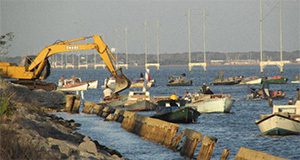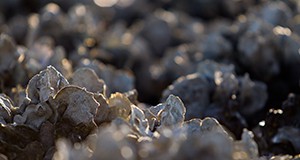The eastern oyster (Crassostrea virginica) provides many important functions in coastal environments, from serving a crucial role in the estuary’s food web to improving water quality for beachgoers and wildlife. Oysters are also a popular food choice for people. At times the commercial industry landings value has topped $8 million annually in Florida. This 2-page facts sheet written by Erik Lovestrand and published by the Florida Sea Grant College Program is one in a series that highlights some of the key ecological and human factors important to the long-term sustainability of this valuable fishery.
http://edis.ifas.ufl.edu/sg143
Tag: Florida Sea Grant College Program
Oysters for the Future: The Value of Science-Based Management in the Oyster Fishery
The eastern oyster (Crassostrea virginica) provides many important functions in coastal environments, from serving a crucial role in the estuary’s food web to improving water quality for beachgoers and wildlife. Oysters are also a popular food choice for people. At times the commercial industry landings value has topped $8 million annually in Florida. This 2-page fact sheet written by Erik Lovestrand and published by the Florida Sea Grant College Program is one in a series that highlights some of the key ecological and human factors important to the long-term sustainability of this valuable fishery.
http://edis.ifas.ufl.edu/sg145
Oysters for the Future: Oystering Rules, The Whys and Wherefores
The eastern oyster (Crassostrea virginica) provides many important functions in coastal environments, from serving a crucial role in the estuary’s food web to improving water quality for beachgoers and wildlife. Oysters are also a popular food choice for people. At times the commercial industry landings value has topped $8 million annually in Florida. This 2-page fact sheet written by Erik Lovestrand and published by the Florida Sea Grant College Program is one in a series that highlights some of the key ecological and human factors important to the long-term sustainability of this valuable fishery.
http://edis.ifas.ufl.edu/sg144
Planning for Recreational Waterway Access in Rural Coastal Settings
Increasing demand for waterfront land throughout the United States is a long-term trend with a profound impact on the public's ability to access coasts and waterways for recreation. Overcrowding at beaches, boat ramps, and popular destinations in Florida's densely populated coastal areas leads more Floridians and tourists to consider recreating in rural coastal communities that still offer the solitude and natural settings desired by many. According to a recent report sponsored by the Outdoor Industry Association, the provision of public water access has increased outdoor recreation tourism, which could bring much-needed economic benefits to rural areas. However, many of these communities lack planning resources to measure local support and user needs and to estimate the benefits that investments in public-access infrastructure might bring. This 6-page fact sheet written by Corina Guevara, Charles Sidman, Robert Swett, and Alan Hodges and published by the Florida Sea Grant College Program describes an approach those communities can use to characterize user needs and to quantify local economic benefits derived from public-access infrastructure with a focus on boat ramp facilities.
http://edis.ifas.ufl.edu/sg141



